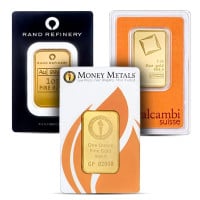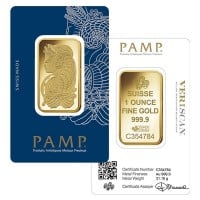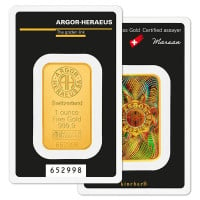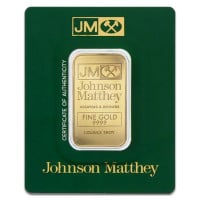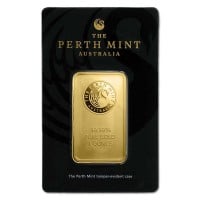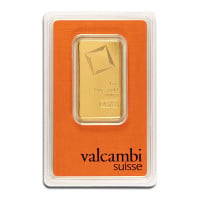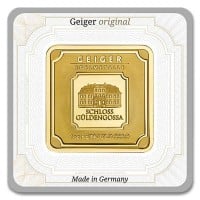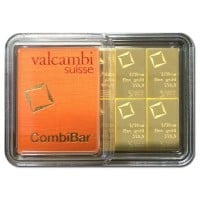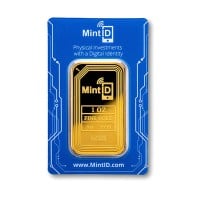1 oz Gold bars
| Qty | Price Each |
|---|---|
| 1 - 9 | $2,424.85 |
| 10 - 19 | $2,417.85 |
| 20 - 50 | $2,410.85 |
| 51+ | Call for pricing |
|
|
|
| Qty | Price Each |
|---|---|
| 1 - 9 | $2,451.85 |
| 10 - 19 | $2,444.85 |
| 20 - 50 | $2,437.85 |
| 51+ | Call for pricing |
|
|
|
| Qty | Price Each |
|---|---|
| 1 - 9 | $2,444.85 |
| 10 - 19 | $2,437.85 |
| 20 - 50 | $2,430.85 |
| 51+ | Call for pricing |
| Qty | Price Each |
|---|---|
| 1 - 9 | $2,423.85 |
| 10 - 19 | $2,416.85 |
| 20 - 50 | $2,409.85 |
| 51+ | Call for pricing |
|
|
|
| Qty | Price Each |
|---|---|
| 1 - 9 | $2,436.85 |
| 10 - 19 | $2,429.85 |
| 20 - 50 | $2,422.85 |
| 51+ | Call for pricing |
|
|
|
| Qty | Price Each |
|---|---|
| 1 - 9 | $2,430.85 |
| 10 - 19 | $2,423.85 |
| 20 - 50 | $2,416.85 |
| 51+ | Call for pricing |
| Qty | Price Each |
|---|---|
| 1 - 9 | $2,453.85 |
| 10 - 19 | $2,446.85 |
| 20 - 50 | $2,439.85 |
| 51+ | Call for pricing |
|
|
|
| Qty | Price Each |
|---|---|
| 1 - 5 | $2,586.85 |
| 6 - 24 | $2,579.85 |
| 25 - 49 | $2,572.85 |
| 50+ | Call for pricing |
|
|
|
| Qty | Price Each |
|---|---|
| 1 - 9 | $2,467.85 |
| 10 - 19 | $2,460.85 |
| 20 - 50 | $2,453.85 |
| 51+ | Call for pricing |
History of 1 oz Gold Bars
Gold was discovered around 5500 BCE. By 4000 BCE, Eastern Europeans were using gold as decorative pieces. Around 3000 BCE humans began fashioning wearable gold jewelry. Finally, around 2500 BCE gold bars were being used for trade although these bars were not yet standardized.
Early on, gold bars were rudimentary and lacking in consistency of purity, weight, and size. It is likely that there was a one-ounce gold bar poured during these days, but not as an intentional cross-cultural standard intended for fair trade or barter.
The first mint is considered to be in Lydia, around 700 BCE to 600 BCE and some accounts suggest 550 BCE, which is in present-day Turkey. By having a mint dedicated to precious metals and coining, including gold bars, gold coins, silver coins, and more, the mint of Lydia was actively working on a standardized weight, size, and purity. This directly inspired others in Ancient Greece, the Roman Empire, Europe, England, Austria, Switzerland, South Africa, Canada, Australia, New Zealand, The United States of America, and beyond.
Today, gold is measured in Troy ounces. A Troy ounce is sometimes abbreviated as t oz and oz t. A Troy ounce weighs exactly 31.1034768 grams, while a standard ounce (also known as an avoirdupois ounce) weighs exactly 28.34952 grams. One Troy ounce is equal to 1.09714 ounces. Precious metals and gems are now weighed in Troy ounces, and this is often assumed when a precious metal item is listed as being 1 ounce for example.
A gold bar is not a normal avoirdupois ounce, rather it is weighed in a Troy ounce even if it does not specify. Nevertheless, it is always a good rule of thumb to make sure that the precious metal purchased is weighed in Troy ounces.
As a side note, silver bars are not as precisely weighed as gold is. A silver bar is much more likely to receive a ranging weight and disclose that exact weight on the bar itself.
The name, Troy, is derived from the 9th Century French town of Troyes where English merchants traded with a more standardized scale measuring system. The weight of a Troy ounce was established around the early 1400s CE and adopted as an official standard weight that we know today in 1527 CE by the British. It was not until 1828 CE that the United States adopted the Troy ounce measuring system.
Due to discrepancies between weight systems, there is no straightforward answer based on historical evidence as to the exact date or year that the first one-ounce gold bar was made. All we know is that the Troy ounce system was made official when it became standardized and shared among other countries, and the fact that the Troy ounce is the world standard today.
So, the first official one Troy ounce gold bar was made in 1527 CE.
Different Types of 1 oz Gold Bars
1 oz gold bars are usually stamped with the purity, weight, and the manufacturer's mark for authenticity. These gold bars can be either cast (sometimes called poured bars or ingots) or minted by refineries and mints. A cast bar is when the precious metal is melted and poured into a mold that sets the shape of the bar. Whereas a minted bar is cut out of a sheet of the precious metal.
A quick way to recognize the difference between the two types of bars is that cast bars tend to have uneven surfaces and rounded, uneven, edges; and, mint bars have a crisp finish with a smooth surface and well-defined edges. Cast bars typically come in gold or silver options, and mint bars can be made in gold, silver, platinum, palladium, or rhodium.
Another significant difference between gold bars is their millesimal fineness. This is a system that denotes the purity of the precious metal such as being 90% pure or 99.9% pure, etc. There are many levels to the fineness scale. The average purity of a 1 oz gold bar is 99.9%, also written as .999 or 999, and sometimes referred to as “three nines” as in “three nines fine.”
It is very common for pure gold or other precious metals bars, coins, or rounds, to be called bullion, such as a gold bullion bar. The word bullion is from French, and it means “boiling” as in the process of melting and boiling the metal into a molten for purification and ridding of impurities as is done in a refinery.
The highest-purity gold bar was refined by the Perth Mint in 1957, and it was 999.999 aka “six nines fine.” The lowest purity a “gold bar” can be legally in the U.S. is one karat which is 1/24 part gold, or about 4.1667% pure, but must be fully disclosed.
Other commonly seen millesimal fineness amounts for gold purity include 999.99 (“five nines”), 999.9 (“four nines”), 999 (“three nines,” most common for 24 karat, minimum for “fine gold”), 995 (minimum for Good Delivery gold bars, minimum for a gold IRA, minimum for 24 karat), 990 (“two nines”), 916 (“Crown Gold,” aka 22 karat), 900 (“one nine”), 585 (14 karat), and 417 (10 karat).
A gold karat (U.S.), or gold carat (Most places outside of the U.S.), is 1/24 part, or 4.1667% of the whole, and the purity of the gold alloy. So, a 24-karat gold bar is at least 99.9% gold, and this is often written simply as 24k.
The difference between 999 and 9999 is mathematically significant and you may or may not pay more for a 9999 over a 999, but the melt value is nearly the exact same as one another. So, most investors are better off getting the lower-cost option to reap the greatest rewards upon selling their gold bar. Be aware that if a 1 oz t gold bar for sale is less than the spot prices of gold, it is likely to not be a genuine 999+, 24k, gold bar.
The investigative process of determining the quantitative and qualitative purity of a gold bar is through a process called gold assaying. An assay is simply a test that determines the purity and content standards of the precious metals being tested. There are two methods of assaying gold bars: fire gold assaying and x-ray fluorescence gold assaying (XRF). Many gold bars, gold items, and bullion products come with an assay card, or in assay, or in a black assay, for verification of the purity, quantity, quality, condition, weights, and other relative notes.
Aside from differences in gold bar types and fineness, there are also differences in aesthetic approaches. Some of these gold bars are smooth with nothing but the basic information marked on one side, while other bars are elaborately decorated with designs and images. There are a variety of gold bar collections, series, and a selection of products to stock up on. The fun gold bar designs, no matter the form, could make for an excellent gift.
Some images on a gold bar may include but are not limited to, Lady Liberty, the Statue of Liberty, Lady Fortuna, Walking Liberty, a swan, kangaroo(s), lion, sovereigns, Britannia, Canadian Maple Leaf or maple leafs, Native American Indian head or buffalo, Lakshmi, name of the refiners, an American eagle, Chinese Lunar Calendar animals, eagles, stars, playing cards, Queen Elizabeth II, a dragon, philharmonic design, various mints' logo(s), Bitcoin symbol, and Saint George.
The size of most one-ounce gold bars is about the same, whether they are cast or minted, plain or designed. The size of a single, one Troy-ounce gold bar, with 9999 purity, is around 2-⅛” W x 3-⅜” L x 3/16” H.
Advancements in the Digital Age have caught up with the gold bar and precious metals industry. This has enabled precious metals companies to incorporate competing technological security features, such as a digital fingerprint called Kinebar by the Germany-based company Argor Heraeus. The Switzerland-based company PAMP Suisse includes a scannable barcode called Veriscan. Another Swiss company, Valcambi, uses four vector symbols embedded into the gold bar as a part of its anti-counterfeit authentication technology.
Many other security features and technologies are being incorporated into the precious metals industry today. These security features are a bonus for some gold bar collectors or investors. However, most buyers of gold bars do not want to pay for those extra features beyond the melt value (spot price) of the gold bar. So, if you are buying gold bars for the sake of investing, it is better not to pay higher costs or higher premiums, for those features. Instead, go with the most basic gold bar you can get without all of the extra technology, designs, or other additional-cost features.
Common Mistakes When Investing in Gold
The most common mistakes when investing in gold are ones that cost an investor more money than they should have really spent. Unfortunately, many new investors and precious metals collectors get swindled by investing in the numismatic, rare coin, market that has extremely high markups.
Many coin-collecting companies will tell you how rare a coin is, and then provide an astronomical price tag claiming the coin is worth more than the melt of the metal content. However, when the investor finally sells the coin, more often than not, they are only offered the melt value of their investment as opposed to the supposed numismatic value. Under most circumstances, it is better to buy a gold coin for its gold content melt value, or gold price, instead of a coin-collecting value.
Another mistake when investing in gold is to purchase gold bars for their designs, name brands, and security features. Suppose an investor or gold stacker wishes to make the most return on investment. In that case, it is better to buy a gold bar that is simply made for its store of value, does not include a significant premium for the name brand, and lacks a security feature that has an added cost. When investing in gold bars, a person should only be thinking about the initial investment for the melt value and anticipating what that will bring in a few years’ time as inflation increases and the value of gold increases.
If a person wants to invest in gold and make the most returns, it is best to invest in gold bullion bars, gold bullion ingots, gold bullion round(s), and gold bullion coins that are not more expensive due to a speculative coin-collecting value. A Gold IRA (Individual Retirement Account) is also a good idea for those who wish to diversify their investment portfolio.
It is always a good idea to buy gold from a reputable gold market dealer instead of someone random online such as eBay, Etsy, Amazon, TikTok, China, or a random new website.
Money Metals Exchange has been in business since 2010 and has received an A+ rating from the Better Business Bureau (BBB) and thousands of 5-star reviews from satisfied customers all over the United States. Money Metals Exchange is also available on social media platforms such as TikTok, Instagram, Facebook, and YouTube; and, Money Metals Exchange is found throughout Google.
Advantages of Investing in 1 oz Gold Bars
1 oz t gold bars are a popular choice for investors looking to buy gold in bulk. Typically, the larger the gold bar a person can invest in, the better, since it is a bulk purchase that enjoys lower premiums than buying smaller bars incrementally. Getting started with one-ounce gold bars is a great investment for beginners as well as more seasoned investors.
1 oz t gold bars are typically more affordable than coins of the same weight because gold bars tend to have lower premiums than gold coins.
Investing in a 1 oz t gold bar enables an investor to physically possess the gold bar, as opposed to letting a safe deposit box in a bank keep it or a depository to hold it. A one-ounce gold bar is small enough and portable enough to store at home, in a home vault, or in a safe, for safekeeping.
There are many seasoned precious metals investors who have learned from examples in history, thefts, and government interventions, that it is usually best to hold the gold yourself than to pay someone else to hold it for you. The further separated an investor is from their physical investment, the less control they have over their investment.
If you do not have the space or the security necessary to store your gold bars at home, be sure to have a reputable company, like Money Metals Exchange, hold onto your gold in the Money Metals Depository.
Popular Brands of 1 oz Gold Bars
There are many popular brands of 1 Troy ounce gold bars. Clients of all experience levels are likely to come across an Asahi gold bar or Sunshine Minting, for example. The following is a non-exhaustive list of popular brands that have produced, and may still be in production of, one-ounce gold bars:
- Johnson Matthey
- Royal Canadian Mint
- The Royal Mint (British)
- Republic Metals
- Asahi
- ABC Bullion
- Ohio Precious Metals (OPM)
- Sunshine Mint
- Australian Perth Mint
- Austrian Mint
- PAMP Suisse
- Credit Suisse
- Valcambi
- Englehard
- Argor-Heraeus
- Rand Refinery
- Scottsdale Mint
- Geiger Edelmetalle
- Umicore
- Metalor
- Emirates
Where to Buy 1 oz Gold Bars
To avoid scams, being overcharged, or being ripped off, it is important to buy gold bars from reputable companies. A reputable gold bar company will not have celebrity endorsements, order with long shipping delays, high-pressure sales tactics, promote numismatic coins over bullion bars, or a poor rating with the Better Business Bureau (BBB).
Money Metals Exchange does not use celebrities to draw people in, has quick shipping times with little-to-no losses, does not use commission salespeople, promotes bullion over coins for best savings and ROI, and has maintained an A+ rating with the BBB and thousands of customers.
When Money Metals Exchange mails your gold bars, 1 oz t gold bars are typically sold in sealed plastic packaging to protect against damage. And, 1 oz t gold bars are often sold with a certificate of authenticity that verifies the bar’s weight and purity. All products and orders mailed by Money Metals Exchange are insured and guaranteed, and will only be delivered with a signature to ensure your products arrive safely and securely.
Money Metals Exchange has been in business since 2010 and has received an A+ rating from the Better Business Bureau (BBB) and thousands of 5-star reviews from satisfied customers all over the United States. If you have questions about placing an order, paying for your purchase, payment methods, navigating your shopping cart or the site, or anything else (FAQ), our friendly customer service representatives and precious metals experts are available to take your calls.
You may call us Mon-Fri during normal business hours on our phone number: 1-800-800-1865
How to Store 1 oz Gold Bars
There are a few good ways to store your one-ounce gold bars in and outside of your home. You can always buy a home safe and securely bolt it to the floor or ground for safe storage. Another option is hiding a safe within the home’s walls or floor. There are also book safes that hide in plain sight among other books on a bookshelf.
For those who do not have the space at home to securely store gold bars, can consider paying for a depository to safely protect their gold valuables such as the Money Metals Depository. This state-of-the-art depository enables a precious metals investor to store their investments with peace of mind.
Money Metals Depository contents are fully insured by Lloyd's of London. All metals stored in your account are fully segregated and are never commingled or rehypothecated — and cannot be used as collateral for a loan by anyone but you. Depository holdings are totally independent and removed from any bank, Wall Street, and Washington, DC. Money Metals' depository building is custom-built to our specifications, using armored in thick steel and hardened concrete. Money Metals Depository uses only top-of-the-line UL Class 3 vaults. Our facility uses 24-hour monitoring and the latest security protocols. Located in low-crime Eagle, Idaho, with the county sheriff's office located on the second floor.
How to Sell 1 oz Gold Bars
When you are ready to sell your one-ounce gold bars on the secondary market, it is important to sell gold to a reputable company that pays you what your gold is worth at a fair price and quickly. Money Metals Exchange has maintained an A+ Rating from the Better Business Bureau (BBB) and thousands of five-star reviews from customers all over the U.S.
To see how much you will receive from selling your one-ounce gold bar to Money Metals Exchange, there are two options. You can either go to the website and find your item, and click on the “click here to sell to us” button, or you can call directly to our phone number to speak with one of our friendly customer service representatives or precious metals experts: 1-800-800-1865
Be sure to sign up for the Money Metals Exchange newsletter to stay informed on precious metals related news, product information, transaction opportunities, and more.





